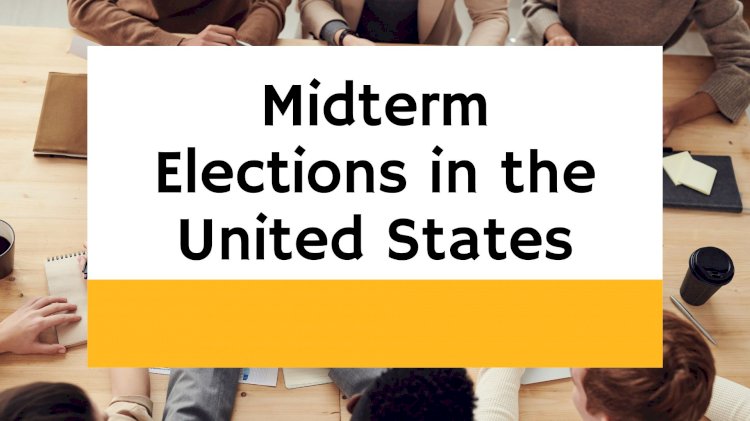Midterm Elections in the United States
Midterm elections, a crucial aspect of the U.S. political landscape, occur every two years, shaping the country's legislative branch and influencing its governance. In this exploration, we delve into the historical significance, frequency, and key aspects surrounding these elections, shedding light on their impact on the nation's political trajectory

Midterm Elections in the United States
Introduction
Midterm elections, a crucial aspect of the U.S. political landscape, occur every two years, shaping the country's legislative branch and influencing its governance. In this exploration, we delve into the historical significance, frequency, and key aspects surrounding these elections, shedding light on their impact on the nation's political trajectory.
Historical Context
Midterm elections have deep roots in American history, dating back to the earliest days of the republic. Understanding their evolution involves examining pivotal events such as the Civil War and the Great Depression, which significantly shaped the dynamics of these elections.
Frequency and Timing
Unlike the four-year cycle of presidential elections, midterm elections take place biennially. This unique timing offers citizens a more frequent opportunity to express their political preferences, impacting the composition of the U.S. Congress.
Importance of Midterm Elections
Midterm elections play a crucial role in determining the balance of power in Congress. As a check on the executive branch, they can alter the political landscape, affecting policy decisions and legislative agendas.
Voter Turnout
Analyzing voter turnout during midterm elections reveals intriguing trends. Factors such as political climate, controversial issues, and the effectiveness of mobilization efforts significantly influence the level of citizen participation in these elections.
Key Players in Midterm Elections
Major political parties, Republicans and Democrats, dominate midterm elections, but third-party candidates also play a role. Understanding the dynamics between these political entities is essential to comprehending the broader implications of the elections.
Campaign Strategies
Candidates employ various strategies during midterm campaigns, utilizing media platforms and advertising to reach voters. Examining these tactics provides insights into the evolving nature of political campaigning.
Gerrymandering
The contentious practice of gerrymandering has a considerable impact on the outcomes of midterm elections. This phenomenon, manipulating electoral district boundaries for political gain, sparks debates over its ethical implications and effects on representative democracy.
Major Issues in Midterm Elections
Identifying prevalent topics during midterm elections offers a glimpse into the concerns shaping voter decisions. Whether it's economic policies, social issues, or international affairs, these issues drive political discourse.
Recent Midterm Elections
Taking a closer look at recent midterm elections, such as those following the 2020 presidential race, provides an understanding of the dynamics at play and the consequences for governance.
Role of Social Media
The advent of social media has transformed the landscape of midterm elections. Candidates leverage platforms to connect with voters, but the dark side of social media, including misinformation and manipulation, poses significant challenges.
Campaign Finance
Examining the financial aspect of midterm elections reveals substantial sums spent on campaigning. The debate over campaign finance reform underscores the need for transparency and fairness in the electoral process.
Predictions and Polls
In the lead-up to midterm elections, predictions and polls become central to understanding the potential outcomes. However, the accuracy and reliability of these projections remain topics of debate within the political sphere.
International Perspective
Comparing U.S. midterm elections with similar processes in other countries offers a broader perspective. The global implications of U.S. midterm results extend beyond national borders, influencing diplomatic relations and international dynamics.
Conclusion
In conclusion, midterm elections stand as a cornerstone of American democracy, shaping the political landscape and determining the nation's course. As we navigate the intricacies of these elections, it becomes evident that their impact extends far beyond domestic policy, resonating on the global stage.
FAQs
-
Why are midterm elections important?
- Midterm elections are crucial as they determine the composition of the U.S. Congress, influencing legislative agendas and the balance of power within the government.
-
What role does gerrymandering play in midterm elections?
- Gerrymandering can significantly impact the outcomes of midterm elections by manipulating electoral district boundaries to favor one political party over another.
-
How do social media platforms influence midterm elections?
- Social media platforms play a pivotal role in midterm elections by providing candidates with a direct means of communication with voters. However, challenges like misinformation also arise.
-
What are some recent examples of major issues in midterm elections?
- Recent midterm elections have seen major issues such as healthcare, economic policies, and social justice taking center stage, influencing voter decisions.
-
How often do midterm elections occur?
- Midterm elections occur every two years, in between the four-year cycle of presidential elections, providing voters with a more frequent opportunity to express their political preferences.
What's Your Reaction?
















